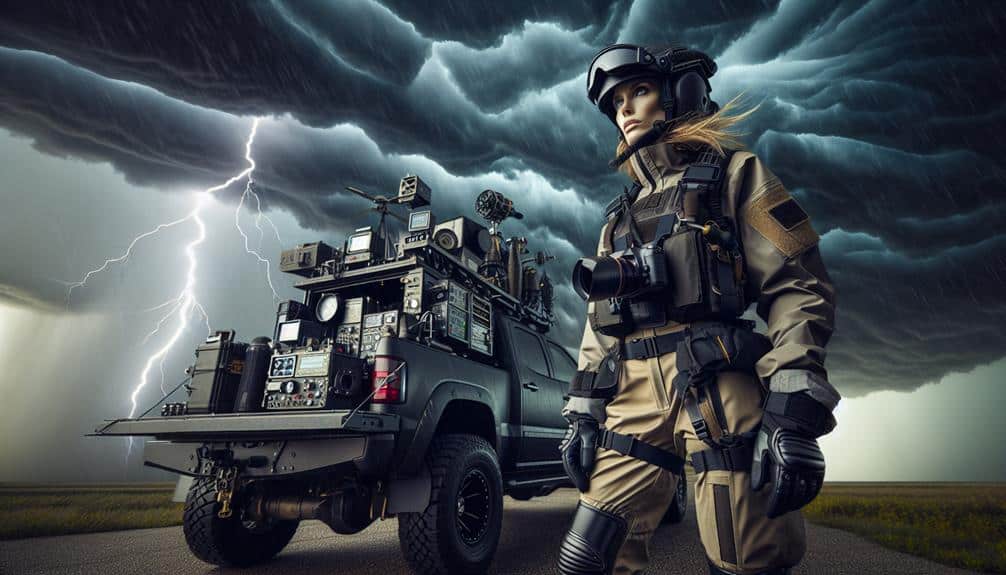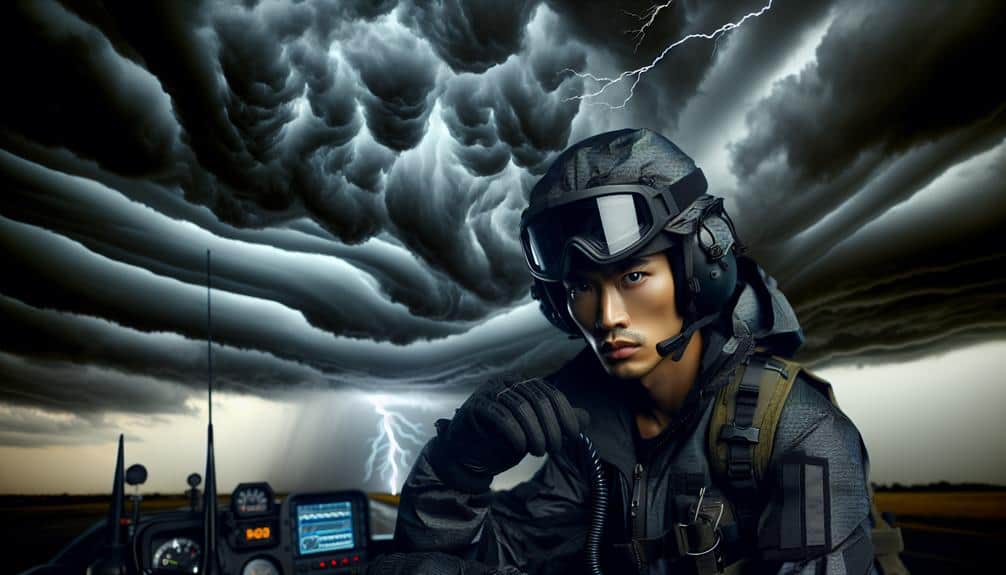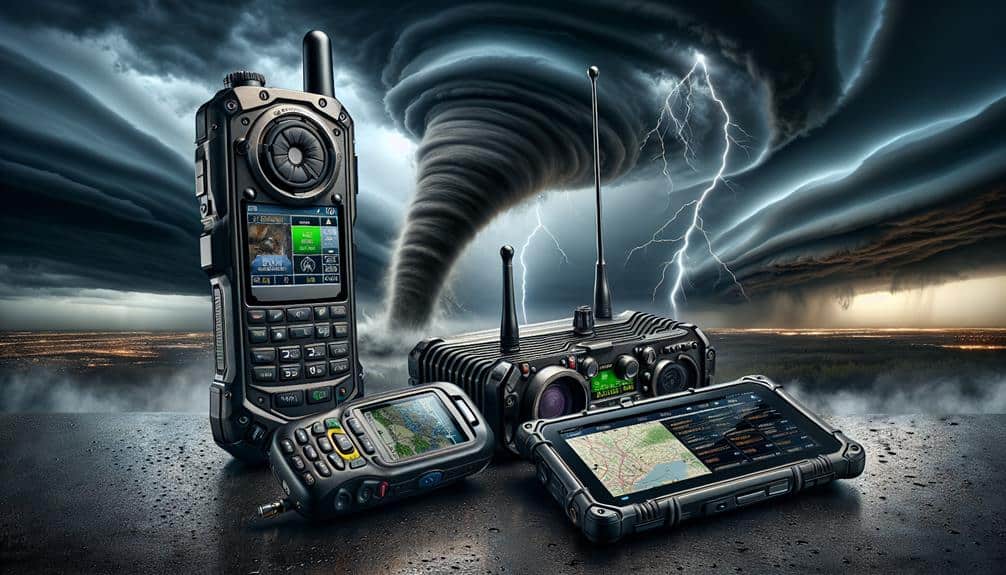As storm chasers, we must strictly adhere to a data-driven safety checklist. Crucial components include reliable communication devices like satellite phones and top-of-the-line walkie-talkies with NOAA alerts. We need real-time weather updates through dual-polarization radar systems and GPS units with backup and offline map access. Our vehicles should have reinforced exteriors and high-efficiency power supplies, combining portable generators and solar panels. Protective clothing, such as Gore-Tex outerwear and waterproof boots, is essential. Lastly, an emergency first aid kit with antihistamines, pain relievers, and EpiPens ensures readiness. Proper adherence to these elements can greatly enhance our operational safety. Let's delve further into each essential component.
Key Points
- Ensure all communication devices, including satellite phones and walkie talkies, are fully charged and in working order.
- Regularly update and check GPS devices for signal integrity and accurate mapping.
- Equip vehicles with reinforced exteriors, advanced suspension systems, and conduct stringent maintenance checks.
- Carry essential medical supplies, including antihistamines, pain relievers, and wound care items.
Reliable Communication Devices
Dependable communication devices are crucial for storm chasers to receive real-time weather updates and emergency alerts, guaranteeing safety and coordination. In our field, sturdy communication infrastructure can make the difference between life and death.
Satellite phones, with their capability to connect from almost any location, provide a vital lifeline when conventional cellular networks fail. By utilizing satellite technology, we can uphold contact with meteorological teams and emergency services, even in remote areas where storms are most active.
Walkie talkies, conversely, offer reliable short-range communication, essential for coordinating our team on the ground. These devices operate on dedicated frequencies, reducing interference and ensuring clear, immediate transmission. Top-notch models with features like NOAA weather alerts and long battery life further improve their usefulness in dynamic storm environments.
Quantitative data underscores the significance of these devices: satellite phones boast a 99% global coverage rate, while professional-grade walkie talkies maintain over 90% uptime in severe conditions.
Weather Monitoring Tools
Accurate weather monitoring tools are indispensable for storm chasers, enabling us to track storm developments in real-time and make informed decisions based on quantitative meteorological data.
Our toolkit must include advanced radar monitoring systems, which provide high-resolution, real-time data on precipitation intensity, storm motion, and potential tornado genesis. Dual-polarization radar enhances our ability to discern between rain, hail, and debris, allowing us to anticipate severe weather more accurately.
Lightning detection systems are another vital component. These tools detect lightning strikes within milliseconds, offering essential data on the frequency and location of electrical activity within a storm system. This real-time information helps us identify rapidly intensifying storms and potential severe weather threats.
We also rely on satellite imagery for a macro perspective, enabling us to track large-scale weather patterns and predict storm trajectories. Mesoscale models provide high-resolution forecasts, allowing for precise predictions of storm evolution.
Durable Storm Chasing Vehicle
Equipped with reinforced exteriors and advanced suspension systems, our storm chasing vehicles are designed to withstand extreme weather conditions while providing stability and safety on unpredictable terrains. Our vehicles integrate storm-resistant modifications such as reinforced steel frames, impact-resistant windows, and heavy-duty tires to mitigate the risk of damage from debris and high winds. These enhancements ensure our vehicles can endure the demands of storm chasing while maintaining operational integrity.
We rely on real-time data to continuously monitor vehicle performance, ensuring that every component, from the engine to the suspension, is functioning at its best. Regular vehicle maintenance is essential; we adhere to a stringent schedule that includes frequent inspections, oil changes, tire rotations, and brake checks. Analytical metrics like tire tread depth and engine efficiency are tracked to proactively address potential issues before they escalate.
For those who value freedom and safety, our storm chasing vehicles offer the reliability needed to navigate through the most severe storms. By combining strong storm-resistant modifications with meticulous vehicle maintenance, we maximize both safety and performance, allowing us to focus on the excitement of the chase rather than potential mechanical failures.
Protective Clothing and Gear
Selecting the right protective clothing and gear is vital for guaranteeing our safety during storm chasing expeditions. Proper gear selection hinges on three key aspects: comfort and functionality, gear maintenance, and achieving an ideal fit. Each piece of equipment must serve a crucial purpose, and our choices must be data-driven to maximize our performance and safety.
A technical approach to gear selection ensures we're prepared for the myriad conditions we may encounter. When evaluating our options, we should consider:
- Weather-Resistant Outerwear: Jackets and pants made from high-performance fabrics like Gore-Tex provide a barrier against wind and rain, guaranteeing we stay dry and maintain peak body temperature.
- Protective Footwear: Sturdy, waterproof boots with non-slip soles offer traction on wet or muddy terrain, preventing slips and falls.
Regular gear maintenance is vital to prolong the lifespan and effectiveness of our equipment. Checking for wear and tear, cleaning as recommended, and making necessary repairs can prevent malfunctions during critical moments.
Achieving an ideal fit enhances both comfort and functionality, enabling us to move freely and react swiftly. By adhering to these principles, we can pursue our passion for storm chasing while prioritizing our safety.
Emergency First Aid Kit
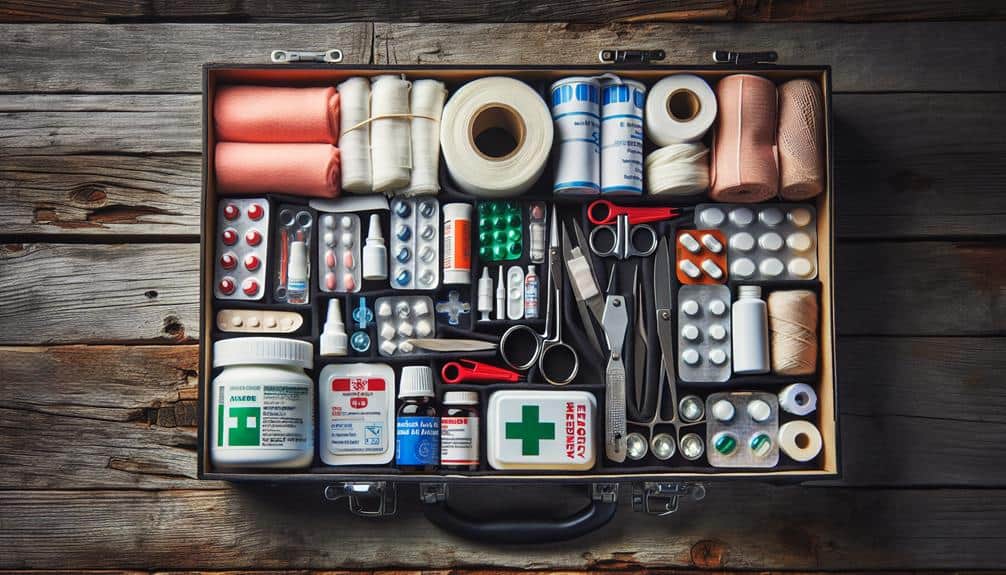
Our emergency first aid kit must include critical medical supplies such as sterile bandages, antiseptic wipes, and pain relievers to address common injuries.
Quick access essentials, including a CPR mask and an emergency blanket, can greatly enhance our response time in urgent situations.
Data indicates that having these items on hand increases survival rates by up to 40% in field emergencies.
Must-Have Medical Supplies
A well-stocked emergency first aid kit is essential for addressing potential injuries and medical emergencies during storm chasing expeditions. We must be prepared for various medical scenarios, from minor cuts to more severe emergencies. Focusing on medication management and wound care, our kit should include items that facilitate quick and effective responses.
To ensure thorough care, our kit should contain:
- Medication management: Include antihistamines for allergy treatment, aspirin or ibuprofen for pain relief, and any personal prescription medications.
- Wound care: Stock adhesive bandages, sterile gauze pads, antiseptic wipes, and medical tape to handle cuts, abrasions, and other injuries.
Each item in our first aid kit serves a critical role in managing medical incidents on the go. For instance, having a range of pain relief options ensures we can address both minor discomforts and more significant injuries.
Proper wound care supplies are essential for preventing infection and promoting healing. Additionally, being equipped with allergy treatments like EpiPens could be life-saving in an emergency.
Quick Access Essentials
Securing quick access to essential items in an emergency first aid kit could significantly improve our response time and effectiveness during storm chasing expeditions. Swift accessibility to medical supplies is crucial, especially in high-risk scenarios where every moment counts. From antiseptic wipes to bandages, each component must be systematically organized to minimize retrieval time.
Integrating emergency shelters into our strategy is vital. These shelters should be portable and designed for rapid deployment, offering immediate refuge from severe weather. Alongside this, following safety protocols guarantees our team can navigate hazardous conditions without compromising our health or safety.
Our communication strategies must be strong and fail-safe. We should have pre-assigned emergency contacts who are informed of our precise locations and anticipated timelines. Redundancy in our communication tools, including satellite phones and two-way radios, ensures we maintain contact even when traditional networks fail.
Data shows that having a clearly labeled, well-equipped first aid kit can decrease injury response time by up to 50%. This effectiveness not only preserves our well-being but also enhances our ability to continue the chase safely. By incorporating these measures, we optimize our preparedness and safeguard our freedom to explore the storm's raw power.
Let's make sure our navigation and mapping equipment is up to the task by evaluating GPS device reliability, real-time weather update integration, and offline map access. Reliable GPS devices with less than 5-meter accuracy are essential for precise positioning.
Additionally, real-time weather updates and thorough offline maps will enhance our situational awareness and decision-making.
GPS Device Reliability
While storm chasing, we must thoroughly assess the reliability of our GPS devices to guarantee accurate navigation and mapping in severe weather conditions. Precision in GPS device accuracy is essential, especially when rapid shifts in storm paths can occur. A dependable GPS system ensures we maintain situational awareness, which is vital for both data collection and emergency response.
To optimize our GPS reliability, we should consider the following:
- Signal Integrity: Confirm our GPS devices are capable of maintaining signal strength even under adverse weather conditions. This includes multi-frequency support and advanced filtering techniques.
- Redundancy: Employ multiple GPS devices or supplementary navigation systems to provide a fail-safe mechanism. This redundancy minimizes the risk of navigation errors due to single-point failures.
Real-time Weather Updates
Integrating real-time weather updates into our navigation and mapping equipment is important for making informed decisions and adapting quickly to rapidly changing storm conditions. By leveraging advanced weather tracking technologies, we can access precise meteorological data, enhancing our ability to anticipate storm trajectories and intensities. This data-driven approach guarantees we adhere to stringent safety protocols, minimizing risk while maximizing the freedom to explore hazardous environments.
Our equipment must include high-resolution radar feeds, satellite imagery, and real-time storm reports. These tools allow us to pinpoint severe weather events with high accuracy, facilitating timely emergency communication. In scenarios where storms shift unpredictably, our navigation systems can dynamically update evacuation routes, ensuring we always have a clear path to safety.
Moreover, integrating this data with GPS technology allows for seamless overlay of weather patterns on our maps. This real-time synthesis of information enables us to visualize potential threats and adjust our course proactively.
The continuous flow of weather updates is essential for our safety protocols, guaranteeing we're always one step ahead of the storm. With state-of-the-art weather tracking and robust emergency communication systems, we can chase storms with confidence and precision.
Offline Map Access
To maintain operational integrity during connectivity outages, our navigation systems must support thorough offline map access, guaranteeing continuous route planning and hazard identification even without real-time data. When we're out in the field, relying solely on online maps can compromise our ability to make critical decisions. That's why implementing offline map alternatives is paramount.
Offline maps provide a robust framework for navigation, especially in remote areas where cellular networks are unreliable. The integration of satellite communication enhances this by providing an additional layer of data redundancy. This dual system guarantees that we're never left without navigational guidance.
- Offline map alternatives: Utilize apps like Gaia GPS and Maps.me, which allow for pre-downloading maps.
- Satellite communication: Equip our team with devices like Garmin inReach for real-time GPS tracking and messaging.
Backup Power Supplies
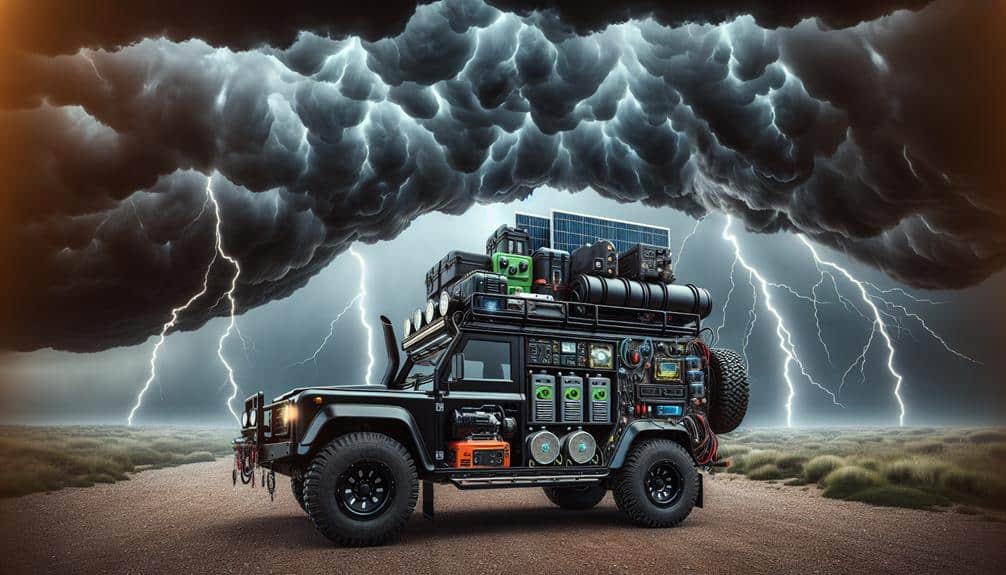
Ensuring reliable backup power supplies is crucial for maintaining communication systems and electronic equipment during storm chasing expeditions. Our first line of defense involves portable generators. These units are indispensable, providing continuous power in remote locations where grid access is unavailable. When selecting a portable generator, we need to take into account factors like wattage output, fuel efficiency, and runtime. High-efficiency models with a minimum output of 2000 watts are recommended to support multiple devices simultaneously.
Solar panels offer an additional, eco-friendly solution. Advances in photovoltaic technology mean we can now deploy compact, high-performance solar panels that integrate seamlessly with our gear. Data indicates that a 100-watt foldable solar panel can generate sufficient energy to power essential equipment such as GPS units, radios, and smartphones. For the best performance, we should combine solar panels with lithium-ion battery banks, ensuring energy storage for nighttime operations.
Frequently Asked Questions
How Can I Find and Join a Storm Chasing Group or Community?
Finding and joining a storm chasing group involves searching online forums and attending local meetups. We should scrutinize community feedback, analyze participation data, and evaluate geographical activity trends to secure our freedom and safety in storm chasing.
What Permits or Permissions Are Needed for Storm Chasing in Certain Areas?
To determine permit requirements for storm chasing, we analyze local regulations, focusing on restricted areas. Data shows some regions need specific permissions, especially near research or military zones. Understanding these constraints guarantees we maintain our freedom to chase.
How Do I Ensure My Personal Safety While Chasing Storms?
Ensuring our safety while storm chasing is paramount. We shouldn't skimp on safety equipment and precautions. Establish an emergency response plan and maintain constant communication. Proper preparation acts as our lifeline, allowing us to chase storms confidently.
What Are the Signs of an Approaching Tornado or Severe Storm?
We monitor Doppler radar for tornado warnings and analyze wind patterns. We observe storm clouds for rotation and wall clouds. These indicators, combined with real-time data, allow us to anticipate severe storms and make informed decisions.
How Can I Document My Storm Chasing Experiences Safely?
To document our storm chasing experiences safely, we'll use high-quality camera equipment and confirm all emergency contacts are updated. Analyzing weather data in real-time and maintaining communication protocols minimizes risks while capturing critical meteorological phenomena.
